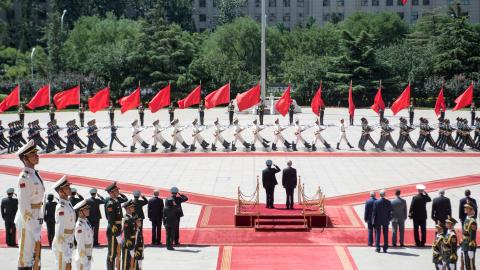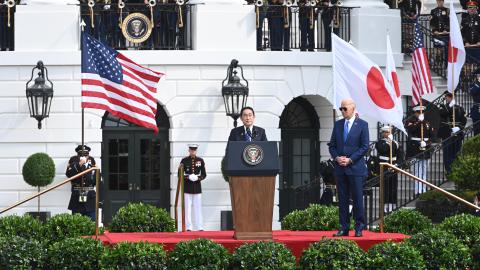With conflicts raging in the Middle East and Europe, the US defense industrial base remains in the news. To address looming shortfalls in manufacturing capacity, earlier this year the Defense Department published its Defense Industrial Base Strategy. It identifies an urgent need for an “industrial ecosystem” to ensure America’s competitive advantage over its adversaries.
The problem is, little in the strategy is new. The document says the right things — the US needs to reduce its supply chain vulnerabilities, develop its workforce and improve cybersecurity. But these problems have been identified for years. It’s another example of what has become a mind-numbing cycle of far too many studies coming out of the Pentagon and the US government as a whole — with little progress on implementation.
Washington is facing a crisis of repetition. It’s a bipartisan crisis, one in which recommendations are made, only for a new administration or leader to start over, looking for “fresh ideas” without considering existing recommendations or why past efforts failed. It’s a waste of taxpayer dollars and the energy of well-meaning, intelligent people who should be focused on fixing the issues, rather than describing them again and again.
Unless Washington takes this crisis seriously, the cycle will continue. The good news is that a few relatively straightforward measures could make a difference. There is nothing “structural” about the crisis. Policymakers should start from the premise that their idea is not necessarily “new” and recognize past efforts to solve a particular problem. Second, they should assume that there are recurring obstacles that have blocked progress and focus on removing or reducing those obstacles. Finally, policymakers should understand where the responsibility for implementation rests and ensure that that authorities exist to do what needs to be done.
One Example Among Many
It’s hard to pick one example to illustrate this crisis of repetition — because there are many. In the national security arena alone, one could point to persistent concerns about America’s weak critical infrastructure or the ongoing cybersecurity problems across the federal government. Domestically, there’s everything from bad infrastructure to bad schools.
But let’s use the problem of America’s continued vulnerability on outside powers for critical minerals. It is now well known that critical minerals are necessary for everything from consumer products to spaceships and virtually all weapon systems in the US arsenal. Yet the US lacks domestic production of many of these minerals and remains reliant on imports for over 50 percent of them. This latest defense base industrial strategy discusses the need to stockpile such materials and avoid supply chain bottlenecks and disruptions.
The problem: Similar recommendations have been made for over four decades.
In 1980, Congress highlighted deficiencies in supplies of certain critical materials, which would impact the ability to supply essential military, industrial, and civilian items. It passed the National Materials and Minerals Policy, Research and Development Act of 1980 so that “ad hoc measures” would be replaced by more formal approaches to rectifying these troubling vulnerabilities.
Subsequently, the Department of Defense and other government agencies expressed concern that the United States imported over half of its supplies of strategically important materials, with the situation “expected to become worse over the next two decades.” That was in 1982.
In the early 1990s, the Department assessed that the US was “almost entirely dependent on foreign countries for strategic and critical materials such as columbium, manganese, platinum, cobalt, and chromium.” At the time, the State Department and DoD argued about the reliability of foreign suppliers. As the decade progressed, various government reports continued to express concern about US “dependence on foreign sources for critical defense materials.”
In 2011, DoD produced a report on its dependence on rare earths minerals, with Congressional voices calling the problem a “crisis.” From 2013 to 2017 legislation and various DoD studies continued to highlight risks in mineral supply chains, problems with single sources of supply, and the need to establish robust domestic sources.
In its first year, the Trump Administration issued an “Executive Order to Ensure Secure and Reliable Supplies of Critical Minerals.” It explained that the US was “heavily reliant on imports” of mineral commodities that were “vital” to our security and economic prosperity. A later executive order called our dependence on critical minerals a “national emergency” and directed the development of a strategy to prioritize a domestic supply chain.
Then the Biden White House issued an Executive Order to examine key supply chains, with a particular focus on critical and rare minerals. Studies followed. A February 2022 Department of Defense report, titled “Securing Defense-Critical Supply Chains,” described US vulnerabilities vis-à-vis critical minerals.
That’s 44 years of policymakers, across the White House, Congress and Pentagon, all agreeing there is a problem — yet, the only solution seems to be more reports. This would be comedic if it weren’t so serious. The United States no longer has the luxury of recycling recommendations. It is time for a fundamental shift from diagnosing problems and making recommendations, to rolling out solutions.
Breaking The Cycle
Four steps could help Washington break this damaging cycle.
First, aggregate what’s already been done. Before officials start an initiative, they should recognize that it is unlikely to be truly new. They should start by collating past recommendations on the topic instead of starting from scratch. This is not glamorous work, but it’s necessary. For example, before a new Executive Order, the White House should spend some time examining past ones on the subject and consider if their own recommendations differ substantially. If not, they need to ask why past recommendations were ignored or not implemented. Every President since George H.W. Bush has issued at least one Executive Order on the need to protect America’s critical infrastructure — every one. Yet virtually all of them contain the same set of recommendations. And the US continues to be vulnerable.
Related to this, a second step is to assess why past recommendations failed to achieve goals and to identify the specific underlying obstacles that prevent progress. For example, permitting regulations add years to the opening of any new mineral processing facility. Thus, it makes little sense to promise that the US will conduct more mineral processing at home unless concomitant attention is paid to streamlining those regulations.
Third, policy officials should research existing legislative authorities in order to understand what tools they have before seeking new ones if there are gaps. Bureaucrats are often risk averse and don’t take actions within these authorities to accelerate progress, even though they are allowed to. Clear guidance by policy leaders to use these authorities is important.
Finally, assign accountability. As one Congressional defense staffer told me recently, “Half the time we are doing back and forth with DoD just trying to get them to say who owns what.” Reports should assign specific offices with implementation of specific steps. The emphasis should be on unity of command — giving a leader authority, responsibility, and resources. This is the approach that enabled Gen. Leslie Groves to complete the Manhattan Project in four years
Both Congress and the Executive branch often mistake report writing for action. Of course, studies have roles to play. They reveal policy viewpoints and shifts. They describe problems and keep the public and policy communities aware of developments. The Department of Defense’s China Military Power report is one example, and there are others.
But we need to focus on the factors that prevent measures from being taken. There are no structural obstacles that prevent leaders from adopting these four steps. Rather, politics, culture, and the fundamentally boring nature of some of the tasks have conspired to impede action.
Leadership could positively impact at least the first two problems. Politics creates obstacles to building on previous work. Partisanship leads to an unwillingness to consider that a previous administration of the other party may have been right or had good ideas. Not every policy has to be defined in opposition to its predecessor. There are some areas, particularly in the national security domain, where there are shared interests. Similarly in Congress, it is often hard to support the other party’s attempt to implement one of your own ideas. Thus, the tendency is to start from scratch.
Culture also matters. Most government organizations suffer from a risk averse culture. This has been cited time and time again. There is a reluctance to stick your neck out to do something for which you can be held accountable. Sometimes leaders break this pattern: Deputy Secretary of Defense Kathleen Hicks took responsibility to deliver thousands of autonomous systems relevant to the China fight within 18-24 months. Those are specific metrics for which she will either pass or fail, but it’s a rare stance. Leadership can shape a culture.
Finally, the challenge of identifying obstacles to implementation is hard — and frankly, not necessarily interesting. It involves detective work: asking questions, knowing processes across government, and understanding funding streams. It requires persistence and takes time. It’s a lot less exciting than coming up with purportedly “new” ideas.
Congress could help drive some of these changes. Instead of requiring the same report year after year, Congress should focus on assessments of why past recommendations have not been implemented. Those assessments should be aggregated, and Congressional staff could work with the Executive Branch to help identify ongoing obstacles.
If new administrations commit to starting with right question: “What has been done before and why did those efforts fail,” they can help break this crisis of repetition. The Defense Industrial Strategy aims to “catalyze generational rather than incremental change,” but revisionist powers like China have mobilized their industries to support military modernization on a vast scale.
Washington doesn’t have a generation to wait. The sooner policymakers stop repeating analyses and focus on overcoming obstacles to implementation, the sooner the United States will be ready to out-compete its rivals.













